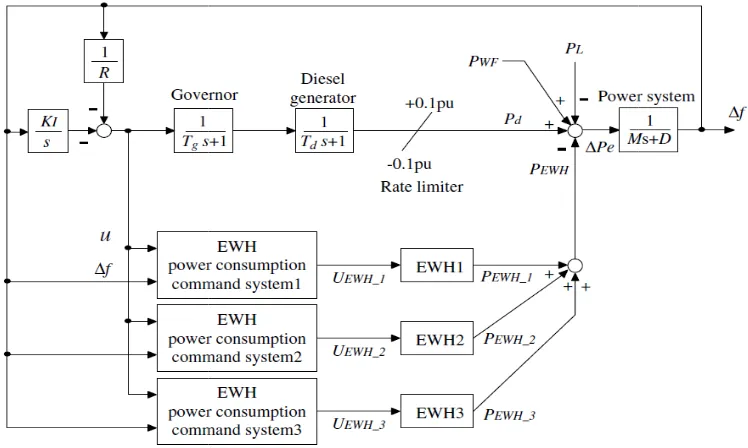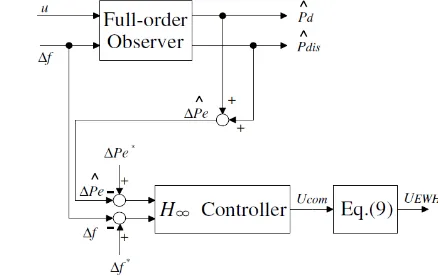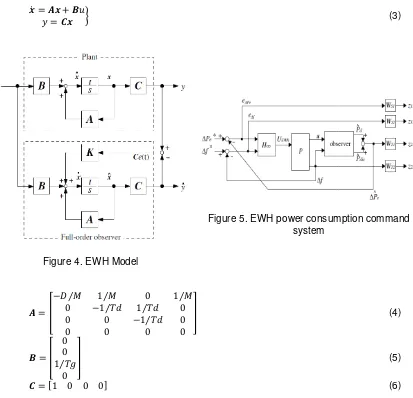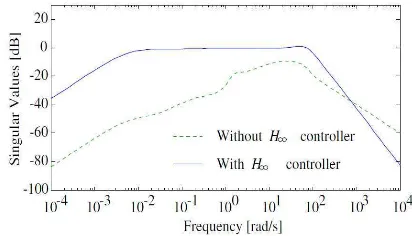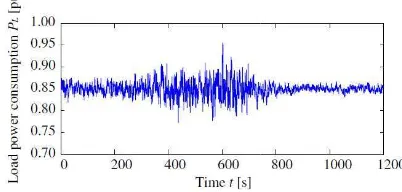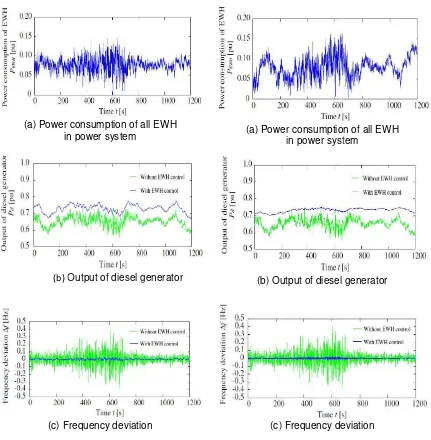ISSN: 1693-6930
accredited by DGHE (DIKTI), Decree No: 51/Dikti/Kep/2010 531
Frequency Control by Decentralized Controllable
Heating Loads with H
∞controller
Yoshihisa Kinjyo, Kosuke Uchida, TomonobuSenjyu
Department of Electrical and Electronics Engineering, University of the Ryukyus, Nakagami, Japan. Email: [email protected]
Abstrak
Banyak sistem daya kecil terisolasi yang dicatu oleh generator diesel, yang menghasilkan biaya operasi lebih besar daripada yang saling berhubungan ke grid yang besar. Oleh karena itu diinginkan untuk mengintegrasikan sumber energi terbarukan seperti tenaga angin ke dalam grid kecil. Namun, karena pembangkit listrik berfluktuasi dari sumber energi terbarukan, penyimpangan frekuensi sistem tenaga menjadi bermasalah. Kendali beban terdistribusi cerdas dapat digunakan untuk meningkatkan penetrasi energi terbarukan secara signifikan dan mengurangi konsumsi bahan bakar solar. Makalah ini menyajikan suatu metodologi untuk kendali frekuensi grid dengan pemanas air listrik sebagai beban terkendali. Sistem ini terdiri dari generator diesel, wind farm, dan beban. Dengan menerapkan sebuah pengendali konsumsi daya yang diadopsi dari teori kendali H∞, deviasi frekuensi grid dipertahankan di sekitar nilai kapasitas. Verifikasi efektivitas dari sistem yang diusulkan digunakan MATLAB / Simulink untuk simulasinya.
Kata kunci: beban terkendali, deviasi frekuensi, kendali H∞, catudaya seimbang, galat catudaya
Abstract
Many isolated small power systems are powered by diesel generators, which results in greater operating costs than interconnected large grids. It is therefore desirable to integrate renewable energy sources such as wind power into these small grids. However, due to the fluctuating power generation from renewable energy sources, frequency deviations of power systems become problematic. Distributed intelligent load control can be used to significantly increase renewable energy penetration and cut diesel fuel consumption. This paper presents a methodology for grid frequency control by electric water heaters as controllable loads. This system consists of diesel generator, wind farm, and loads. By applying a power consumption controller adopted from H∞control theory, grid frequency deviation is maintained around rated value. In order to verify the effectiveness of the proposed system, MATLAB/Simulink is used for simulations.
Keywords: controllable load, frequency deviation, H∞control, supply balance, supply error
1. Introduction
Behind the steady increase in demand for energy that is envisaged in the future are reasons for electric power development for various utilities, including buildings and electric vehicles. These, however, increase the chances for rapid fluctuations of power loads. Demand for energy has shown an upward trend in most of the islands, which are supplied by diesel generators.
3,000,000kW and 820,000kW generation from renewable e system become problematic.
In cases where abo systems as on islands, diese balance of supply and deman limits with respect to maintain with governors have automa generator has been proposed with output power leveling by energy. There is power consu as another method for frequ demand [3]. In fact, there is a appliances for each customer to suppress the frequency de which may steadily increase a
This paper presents a a small power system. Decent supply and demand, thereby used in this paper which poss frequency domain. Controllab side to suppress the high-fre long-time constant is control Electric water heater is used proposed control system is va
2. Power System Model Figure 1 illustrates the and wind farm in small power independently without connec supplier; the system capacity i
kW, in Japan by 2010. However, due to the energy sources, voltage and frequency deviati
bove-mentioned electric power fluctuation occur sel generators are used to control the frequency and by governor free operation [1]. But diesel gene ining the balance of supply and demand because
atic constraint. On the other hand, pitch angle ed for control of dispersed power system [2], but so y automatic constraint of control mechanism and ir sumption control of decentralized controllable loads
quency deviation control to maintain the balanc a specific example that power consumption contro er on some island in Britain [4]. In addition, it is effe deviation using electric vehicle with storage batte as controllable load in the load side in the future.
Figure 1. Power System Model
a method for system frequencycontrol using dece entralized controllable loads are controlled to mainta
y suppressing frequency deviation. To control, H ssible controller design about consider a response able loads which have a short time constant expen frequency component of supply error. Diesel gen rolled to suppress the slowly varying component ed as controllable load in this paper, and the eff validated by simulation results in MATLAB.
the small power system proposed in [5]. There are er system which supplies electricity for power dema ection with large-scale power system as the gene ty is 20MW which is the fundamental base in Per Un
fluctuating power iation of the power
ur in small power ncy to maintain the enerators have their e diesel generators le control on wind sometimes interfere d irregularity of wind ds on the load side nce of supply and trol of home electric effective that control ttery not mere load
centralized loads in intain the balance of
∞control theory is
se characteristic of end energy in load enerator which has nt of supply error. effectiveness of the
are 600electric water heate represents 16.2% of system control of the power system. frequency deviation ∆f of syst the output power of diesel gen electric water heater, and pow
∆
where Pdis and ∆Pe represent consumption, and supply erro in Figure 1.with supply error g
Figure 2. EWH Mo
3. Electric Water Heater EW Electric water heater i type with 4.4kW heater, to hea midnight power. The electric w heater is modeled as a first or water heaters are decentralize (EWH1), 5.4kW (EWH2), and
4. EWH Power Consumption EWH power consum EWH and its configuration is d at the small power system consumption of load, when it consumption command syste deviation ∆f are desired to be full-order observer as explain EWH power consumption us controller using H∞ control the control performance on the fre with use of PI controller and H
4.1.Design of Full-order obs The full-order observ system by constructing the s Output power of diesel gener
ters in the proposed system whose total capa m capacity. Flat frequency control method is us m. This method controls the output of diesel gen
stem frequency toward zero. Pd, PWF, PL, PEWH in F generator, output power of wind farm, all power con
ower consumption of electric water heater, respectiv
ent the difference between output power of wind rror. Frequency deviation ∆f is computed using the
generated in the power system.
odel
Figure 3. EWH power consum system
WH
r is used for hot water supply of the home. The stan eat the water until between 55◦C (summer) and 85 c water heater model is illustrated in Figure 2. The e order lag system, and time constant T is0.1s. There ized in system, with rated power consumption of, re
d 6.4kW (EWH3).
ion Command System
mption command system is to control the power is described in this section. Imbalance of supply an
m from fluctuation for output power of wind it is resolved, then frequency deviation is suppres
tem is illustrated in Figure 3. The supply error ∆P be zero. First the supply error is estimated by estim ined in the next section. Next, controller is design using estimated supply error ∆P̂e and frequency theory is designed in order to decide the quantita frequency domain. The proposed method is examin
H∞ controller in the simulation outcome.
bserver Figure 1 represent consumption except ctively:
(1) (2)
nd farm and power the transfer function
mption command
tandard is a 370l 5◦C(winter) using e electric water ere are 600 electric
respectively,4.4kW
er consumption of and demand occurs d farm and power essed. EWH power Pe and frequency stimated result from igned to control the cy deviation ∆f. H∞
itative evaluation of ined by comparing
frequency deviation ∆f and deviation ∆f. The state equatio
Figure 4. EWH Mo
⁄ 1 ⁄
0 1 ⁄
0 0
0 0
0 0
1 ⁄
0
1 0 0 0
where x is the state variable diesel generator Pd, output of Full-order observer is configu Figure 4.
Where the poles of the obs estimate. Supply error ∆P̂e is
P̂d and estimated value of dist
∆
It is used the decision of input
4.2 Design of H∞controller Two-input one-output e∆Pe and e∆f, where e∆Pe is dif error ∆P* e which is always 0 value of supply error ∆f*whic
input signal of governor u which can compute tion has the form:
odel
Figure 5. EWH power consum system
0 1 ⁄
1 ⁄ 0
1 ⁄ 0
0 0
le vector, x1, x2, x3, x4 represent frequency devia of governor, disturbance of power system Pdis=PWF
igured by the followingequation and block diagram
!
bserver (γ1=-80, γ2=-0.2, γ3=-10, γ4=-60) are dec is estimated by estimated value of output power of isturbance of power system P̂dis using the following
ut signal for controller which is explained in the nex
ut H∞ controller is designed in this section. Input o
ifference between supply error ∆P̂e and comman
s 0,e∆f is difference between frequency deviation hich is always0. Linear matrix inequality (LMI) ap
ute from frequency
(3)
mption command
(4)
(5)
(6)
viation ∆f, output of WF-PL, respectively. ram is illustrated in
(7)
decided by a good of diesel generator
ng equation
(8)
ext section.
t of H∞ controller is
applied to the design of the H following are the design goals
On the load side, EWH e
error. Weighting function sensitivity at the high freq
On the generator side,
component of supply erro as to low sensitivity at the
(a) Weighting functions of sen
(b) Weighting functions of co sensitivity functio
Figure 6.Singular value plots functions
Weighting functions W illustrated in Figure 6(a),(b). command value following c complementary sensitivity fun illustrated in Figure 6(b). Rob Singular value plots of diesel illustrated in Figure 7, and 8, controller addition as shown frequency component of supp zero at the low-frequency com as shown in Figure 8, EWH error by singular value plots o singular value plots of diesel the low-frequency component domain.
H∞controller. Controller configuration is illustrated ls:
expend energy to reduce the high-frequency com tions of sensitivity function WS1, WS2are selecte
equency component.
, diesel generator generates power to reduce th rror. Weighting function of sensitivity functionWS1, the low-frequency component of supply error.
ensitivity function
complementary tion
ots of weighting
Fig. 7 Singular values plot of
Figure 8.Singular values p
WS1, WS2, WT1, and WT2are selected by design go ). Weighting functions of sensitivity function WS1,W
capability as illustrated in Figure 6(a). Weigh function WT1, WT2decide the robustness against th
obustness for parameter variation is examined in el generator and EWH for before-after the additio 8, respectively. From singular value plots of diese
in Figure 7, the diesel generator generates to pply error by gain of diesel generator that is maint omponent. From singular value plots of EWH after c
can operate to reduce the high-frequency com s of EWH as configured at the high-frequency dom
el generator. Electricity consumption of EWH has ent of supply error by gain of EWH declining at th
ted in Figure 5. The
omponent of supply ted so as to high
the low-frequency , WS2is selected so
f diesel generator
s plot of EWH
goals in Figure 5 as WS2determine the ghting functions of the disturbance as in the next section. itional controller are esel generator after to reduce the low-intained constant at
Figure 9. All power consumpti
Figure 10. WF output
4.3 Distributed control EWH group power co on each capacity. In other wo EWH is chosen according to consumption command value
"_ _#
$
∑_
where PEWH_maxN and η represe
5. Simulation Result and Dis The simulation result consumption control of decent command system, H∞control shows the parameter of the po
Variations of all powe assumed in this paper as sho Figure 9 has sharp fluctuation to operate at peak power and for good estimate as seen in F Simulation results are controlled by a PI controller. P Figure 12(a), and EWH expen supply error ∆Pe as seen in th EWH and with using EWH component is reduced by pow in Figure 12(c). Frequency de that is done so as to reduce th
ption except EWH
put power
Figure 11. Disturbance of po estimated val
Table 1.Simulation P
inertia constant M damping constant D governor time constant Tg
diesel generator time constant Tg EWH time constant T
consumption is controlled by decentralized contro words, command value for determining the powe to capacity of EWH. The following equation de
e of EWH from the foregoing concept:
# $ %_
&
esent rated power consumption of EWH and propor
iscussion
ults show the effectiveness of system frequency entralized controllable load in load side. In EWH po
roller is compared with using PI controller for sim power system used in the simulations.
wer consumption except EWH and output power hown in Figure 9 and 10. Power consumption of ion between about 400sand 800s. Moreover, wind d simulated with random fluctuation. The full-order Figure 11 illustrates disturbance Pdis and the estim re shown in Figure 12 for the case where the sys . Power consumption of all EWH in the power syste end electric power so as to reduce the high-frequen this figure. Output power of diesel generator, in c on control, is illustrated in Figure 12(b), and ower consumption control of EWH. Frequency devi deviation is suppressed in about ±0.04Hz due to po
the high-frequency component of supply error on t
f power system and value
troller that depends wer consumption of nd farm is assumed er observer running timated value P̂d. system frequency is
(a) Power consumption o in power system
(b) Output of diese
(c) Frequency devi
Figure 12. Simulation result
On the other hand, sim illustrated in Figure13. Power 13(a), and EWH expend elect error ∆Pe and keep pace und generator Pd becomes smooth than the case of using PI con 13(c). Next, frequency deviatio method for parameter variation frequency deviation ∆f. Howev
' √ exp +% &
where σ(>0), x and µ represe Variable parameters are assu equivalent generator’s parame
n of all EWH tem
esel generator
eviation
ults (PI control).
(a) Power consumption in power syste
(b) Output of diesel g
(c) Frequency de
Figure 13. Simulation resu
simulation outcome in case of using H∞ control on er consumption of all EWH in power system is illu ctric power so as to reduce the high-frequency com nder the high-frequency component. Then outpu oth and constant. It is seen that the case of using H
ontrol for frequency deviation ∆f, as seen in contro ation ∆f is statistically evaluated to show the validit tion. The following equation is used to show the pro ever, it is assumed as form of normal distribution
&,
sent standard deviation, sample ∆f, and mean va ssumed which are diesel generator’s parameters meter M.
ion of all EWH stem
el generator
deviation
sults (H∞control).
on control system is illustrated in Figure omponent of supply put power of diesel H∞ control is better
trol result of Figure dity of the proposed robability density of
(11)
Figure 14. Probability densit deviation (PI cont
Scope of parameter variation deviation in case of using ea results for PI control of Figure lower at 0 Hz, while the frequ Statistical results for H∞cont
deviation is maintained at a Therefore, it can be observed variations.
6. Conclusion
This paper presents a using controllable load that ma expend electric power to redu diesel generator generate to r side from estimated supply e which can decide the control p achieved: demand side supp power of diesel generator, as by the H∞ controller that has ro
References
[1] Inoue T. MW Response of the IEEJ. 2004; 124-B(3): 34 [2] Senjyu T, Sakamoto R, Ura
Turbine Generators using Pi of the IEEJ. 2005; 125-B(12 [3] Kondoh J, Aki H, Yamaguc Supply Balance. Transaction [4] Taylor P. Increased Renew
Fuzzy Load Control. Renew [5] Senjyu T, Kaneko T, Yona
Utilities. Annual Conference [6] Chilali M, Gahinet P. H∞ des
on Automatic Control. 1996; [7] Scherer C, Gahinet P, Chila Trans. Automatic Control. 19 [8] Gahinet P, Nemirovski A,
Mathworks Inc. 2000. [9] Chiang RY, Safonov MG. Ro [10] Skogestad, Postlethwaite I
Sons Ltd. 1996.
sity of frequency
ntrol). Figure 15. Probability den deviation (H∞ co
tion is between −10% and −40%,probability den each control method is illustrated in Figure 14,
ure 14 confirm that rate of distribution for frequenc quency deviation band widens with increase in par ntrol of Figure 15 confirms that rate of distributi a high level at 0 Hz even though parameter vari ed that the proposed control system shows robustn
s a control system to achieve suppression of frequ may steadily increase in the load side in the future. duce the high-frequency component of supply erro o reduce the low-frequency component of supply e y error of power system by full-order observer us
l performance on frequency domain. It is found that pply balance is maintained, generating-power le as well as suppressing frequency deviation for par
robustness.
of Thermal Power Plant from Viewpoint of Power Syste 343-346.
rasaki N, Funabashi T, Fujita H, Sekine H. Output Pow Pitch Angle Control for All Operating Regions in Wind 12): 1159-1168.
uchi H, Murata A, Ishii I. Study on Load Control Method tions of the IEEJ. 2004; 47(5): 29-54.
ewable Energy Penetration on Island Power Systems ewable Energies for Islands Toward 100% RES Supply. A, Funabashi T, Power Control of Wind Farm Connec ce of Power & Energy Society. 2007; 62: 49-31- 49-38 esign with pole placement constraints: an LMI approach.
6; 41(3): 358-367.
ilali M. Multiobjective Output Feedback Control via LMI 1997; 42(7): 896-911.
, Laub AJ, Chilali M. LMI Control Toolbox For Use w Robust Control Toolbox for Use with MATLAB. The Math
I. Multivariable Feedback Control: Analysis and Desig
ensity of frequency control).
ensity of frequency , and 15.Statistical ncy deviation to be parameter variation. ution for frequency ariations increases. stness to parameter
quency deviation by re. Controllable load ror in load side and ly error in generator using H∞controller hat the following are leveling of output arameter variations
stem. Transactions of wer Leveling of Wind d Farm. Transactions hods for Demand and s through Distributed
Greece. 2001 ected to Small Power
ch. IEEE Transactions MI Optimization. IEEE e with MATLAB. The
